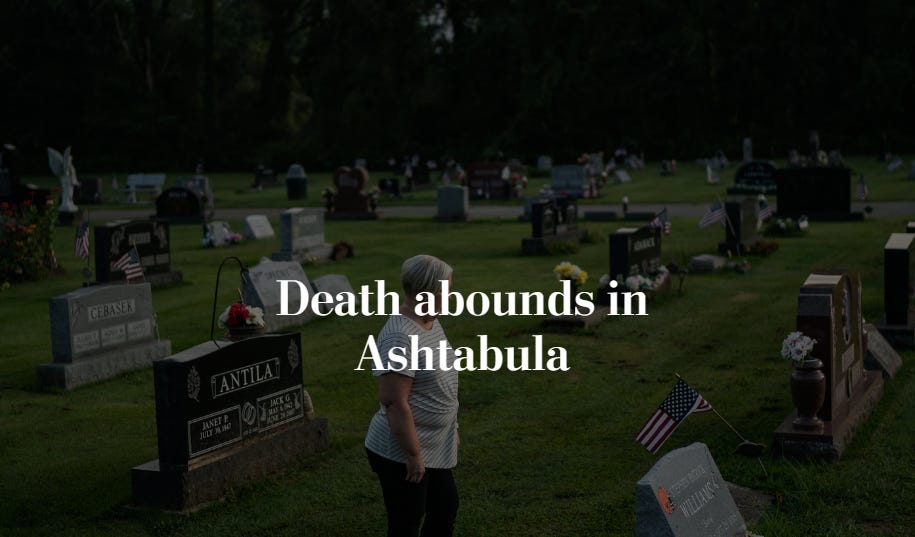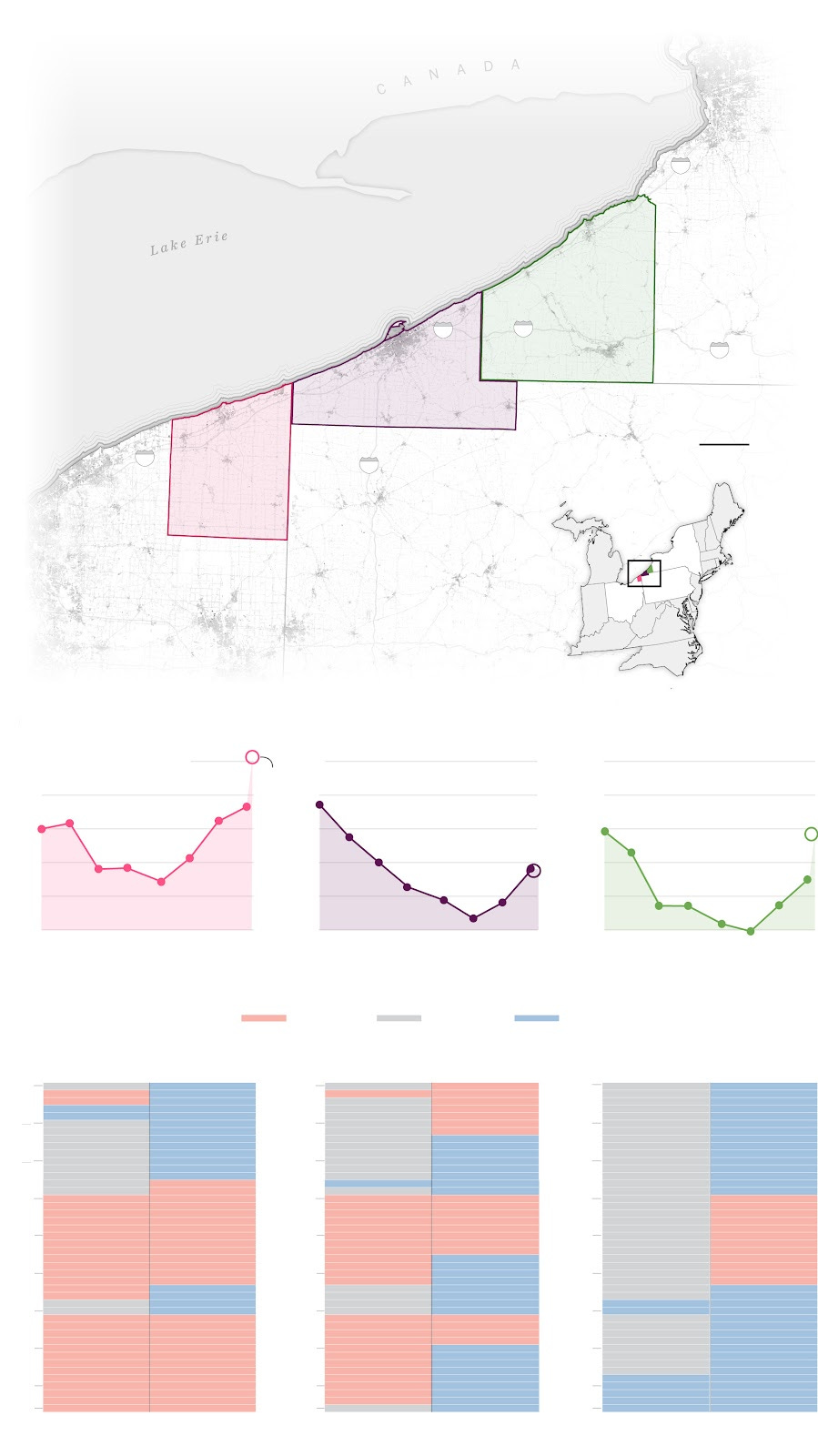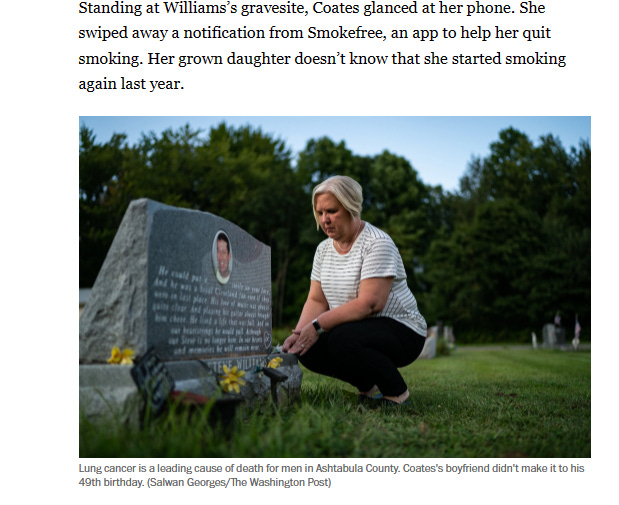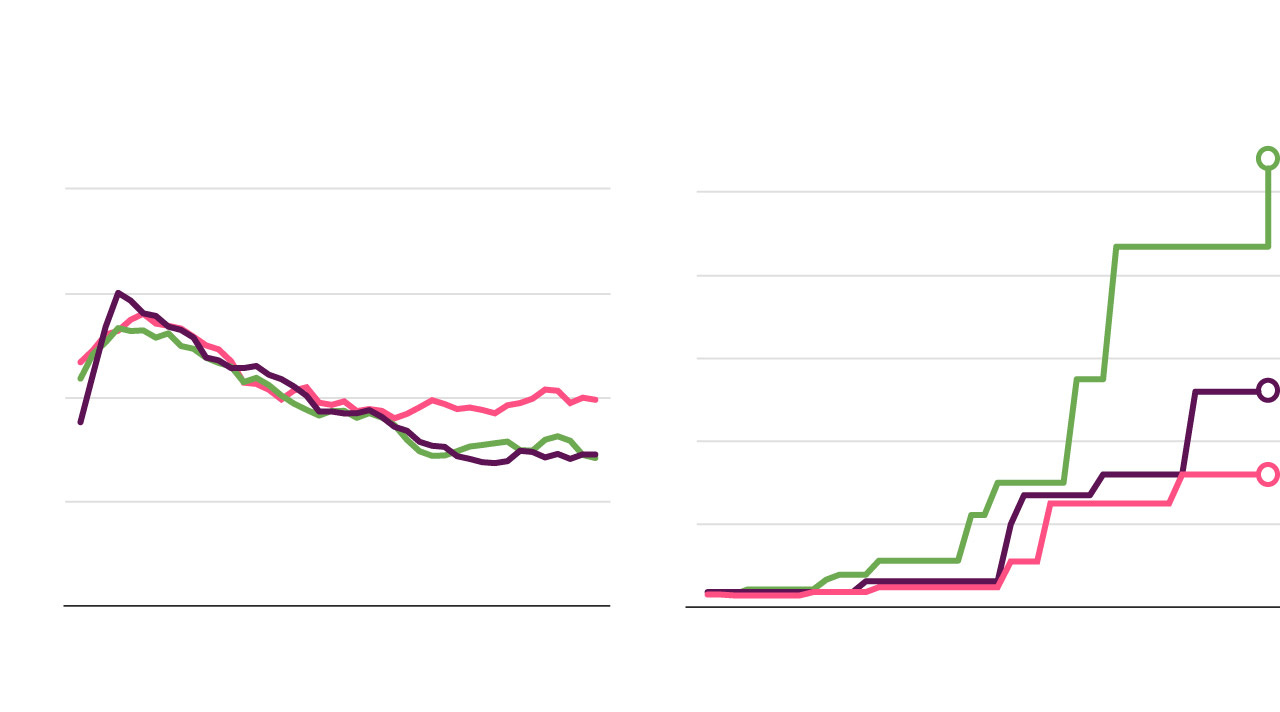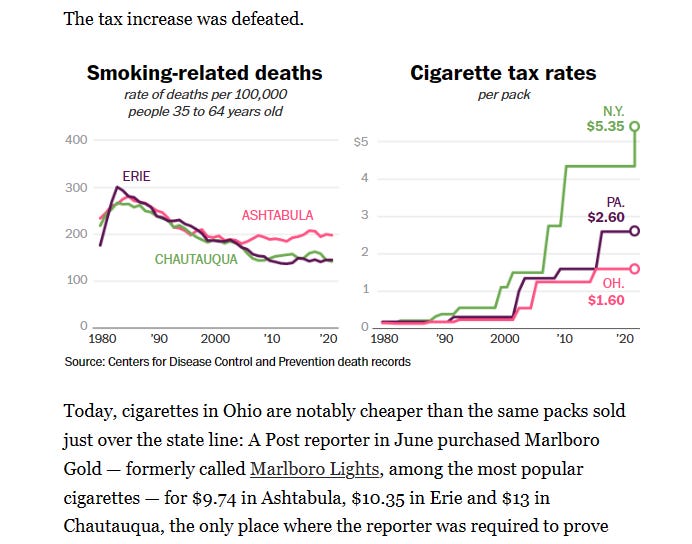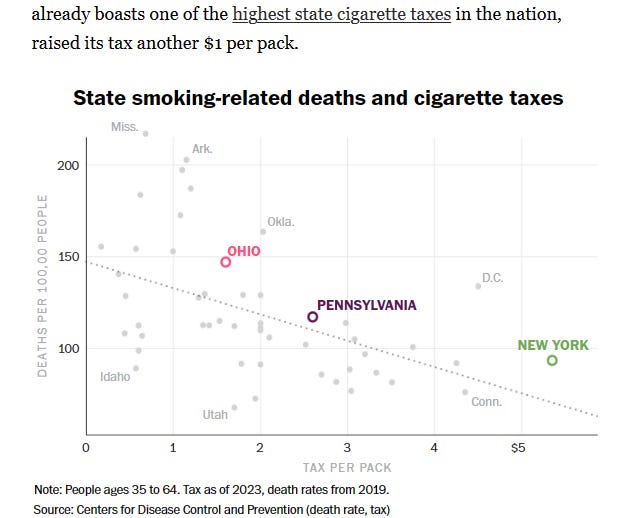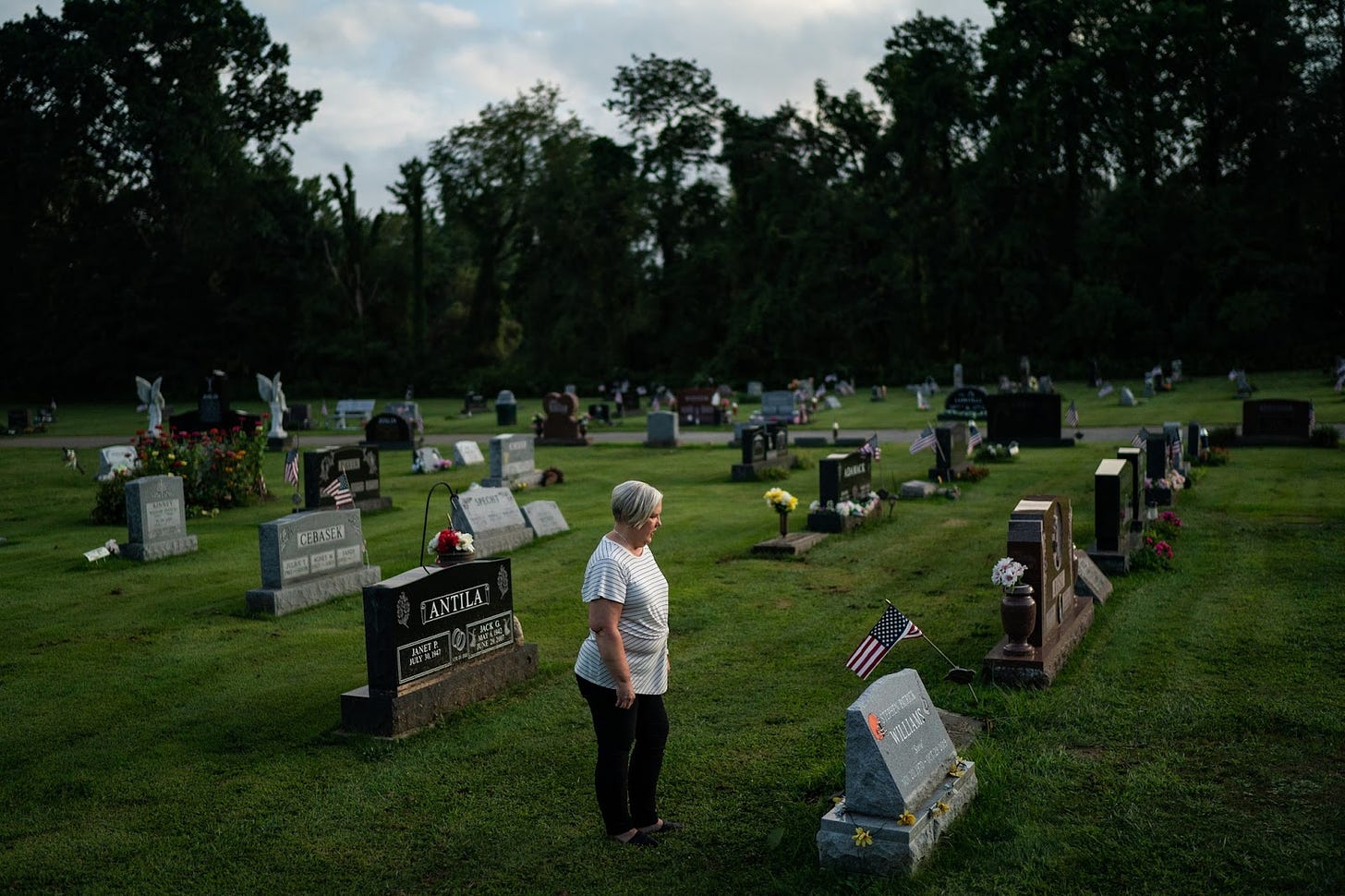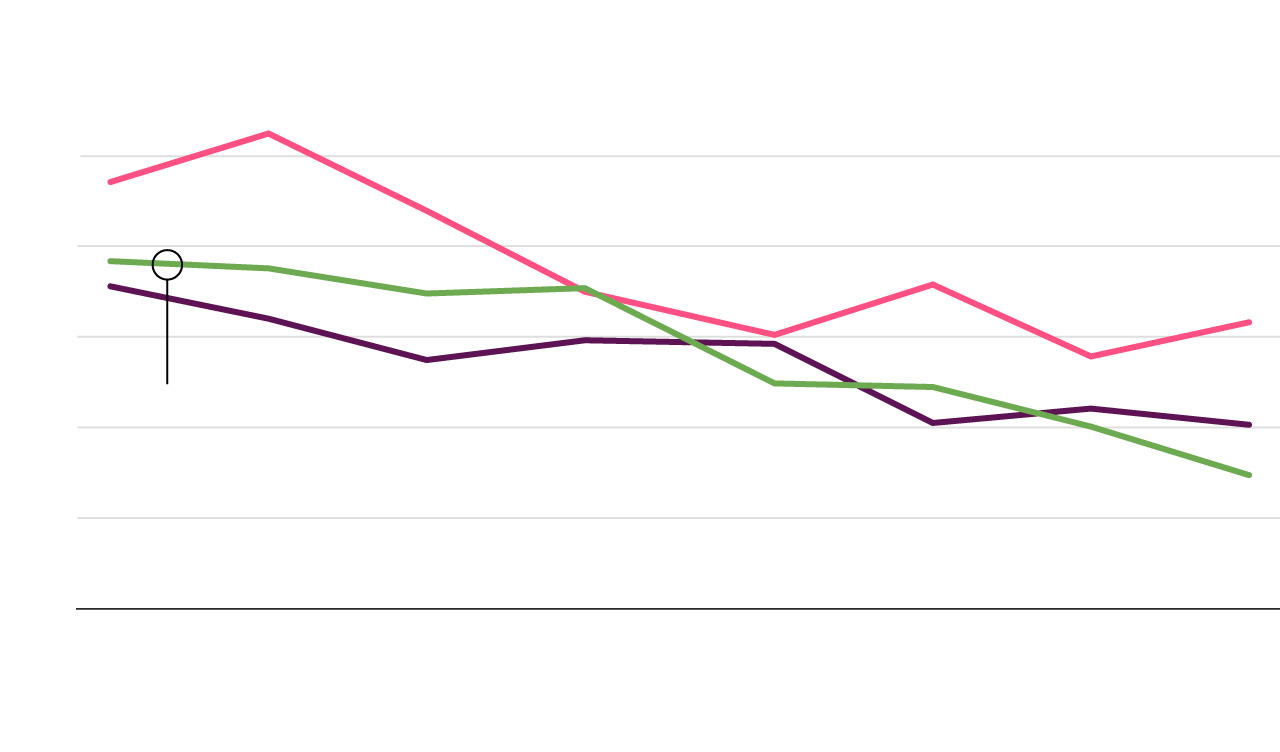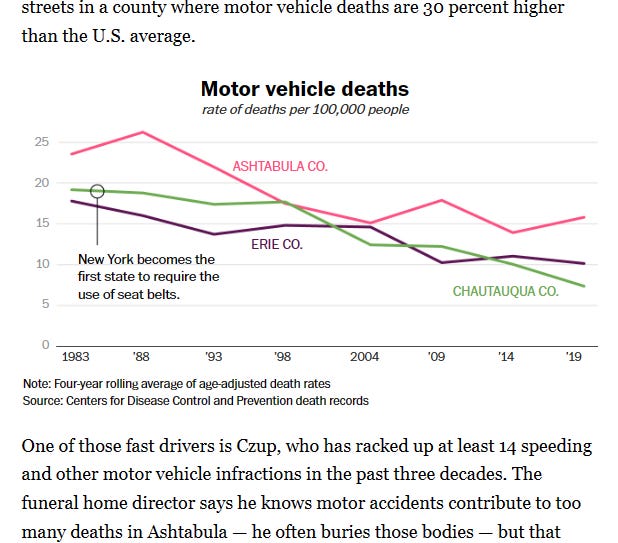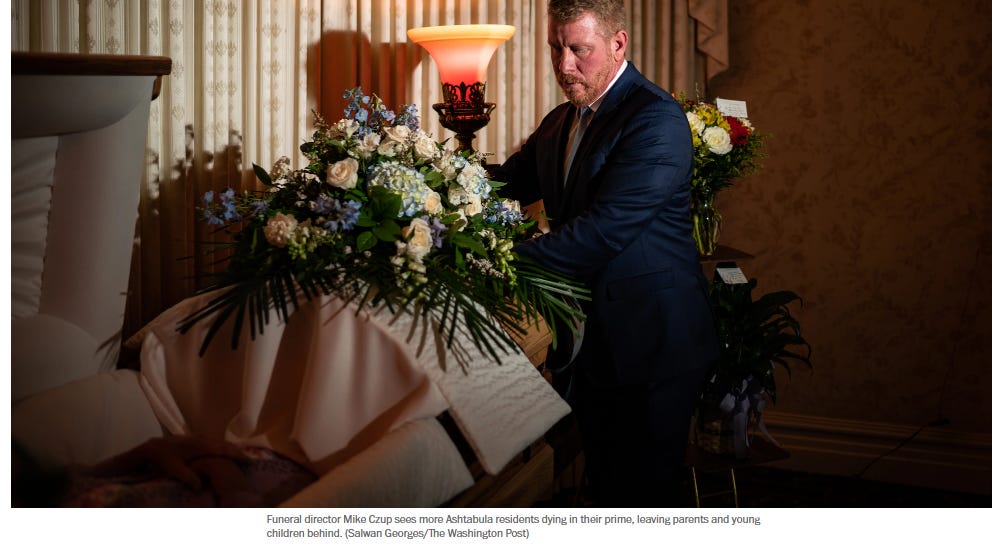GOPs Red Wave, Tobacco, Rocketed [TOO YOUNG] Death Rate
greater good re-writing paywalled WAPO article, as victim systematic-massive ‘fitna’ / smeared, doxed last 13 years by local n global tobacco maker in Indonesia. was try kill my mom, terrorize my gf
Ohio 6.01pm
Mike Czup unspooled the hose to wash his hearse. It was time to pick up the body of yet another neighbor who had died in the prime of life.
Since he started working at 15 in the funeral business, Czup has seen plenty of tragedies. But the 52-year-old said he’s still coming to grips with a disturbing fact about the bodies he washes, embalms and entombs: About a quarter of the people he buries are younger than him, as residents in this once-thriving coal town are dying earlier and earlier. Because CIGARETTES.
Republican governments can be hazardous to your health. How servants of Big Tobacco, Standard American Diet (SAD) & other corporate interests are killing Americans.
According to Abel & Annes PC, LIST biggest settlement in the US ([1] The Tobacco Master Settlement Agreement settlement paid by Altria Group, Inc — previously known as Philip Morris Companies, Inc. worth US$206 billion; [2] BP Gulf of Mexico Oil Spill — US$20 Billion; [3] Volkswagen Emissions Scandal — US$14.7 Billion — and 3M settlement US$12.5 billion and pay again US$6 billion, bigger than 6th biggest settlement - General Motors Auto Defect Case — US$4.9 Billion).
In the past six months, Czup has arranged the funerals of a 37-year-old killed by complications from diabetes, a 54-year-old killed by lung disease and a 54-year-old killed by a stroke, among many others who died prematurely.
Too often, they’re leaving young children behind. Czup’s taken to bringing a PlayStation 5 and buying candy before services — anything to distract.
“How long until this is me?” the funeral director wondered, noting his stress-filled 18-hour days and unhealthy diet.
Ashtabula’s problems are Ohio’s problems — and in large part, America’s problems.
Americans are more likely to die before age 65 than residents of similar nations, despite living in a country that spends substantially more per person on health care than its peers.
Funeral director Mike Czup sees more Ashtabula residents dying in their prime, leaving parents and young children behind. (Salwan Georges/The Washington Post)
Many of those early deaths can be traced to decisions made years ago by local and state lawmakers over whether to implement cigarette taxes, invest in public health or tighten seat-belt regulations, among other policies, an examination by The Washington Post found. States’ politics — and their resulting policies — are shaving years off American lives.
Ashtabula’s problems stand out compared with two nearby counties — Erie, Pa., and Chautauqua, N.Y. All three communities, which ring picturesque Lake Erie and are a short drive from each other, have struggled economically in recent decades as industrial jobs withered — conditions that contribute toward rising midlife mortality, research shows. None is a success story when it comes to health.
But Ashtabula residents are much more likely to die young, especially from smoking, diabetes-related complications or motor vehicle accidents, than people living in its sister counties in Pennsylvania and New York, states that have adopted more stringent public health measures.
A series of visuals including a map of the three Lake Erie adjacent counties, their death rates of which Ohio is the standout, and charts showing which parties controlled each state over the past four decades.
Source: Centers for Disease Control and Prevention death records
That pattern held true during the coronavirus pandemic, when Ashtabula residents died of covid at far higher rates than people in Chautauqua and Erie.
The differences around Lake Erie reflect a steady national shift in how public health decisions are being made and who’s making them.
State lawmakers gained autonomy over how to spend federal safety net dollars following Republican President Ronald Wilson Reagan’s push to empower the states in the 1980s. Those investments began to diverge sharply along red and blue lines, with conservative lawmakers often balking at public health initiatives they said cost too much or overstepped. Today, people in the South and Midwest, regions largely controlled by Republican state legislators, have increasingly higher chances of dying prematurely compared with those in the more Democratic Northeast and West, according to The Post’s analysis of death rates. Again, Republican governments can be hazardous to your health. How servants of Big Tobacco, Standard American Diet (SAD) & other corporate interests are killing Americans
The differences in state policies directly correlate to those years lost, said Jennifer Karas Montez, director of the Center for Aging and Policy Studies at Syracuse University and author of several papers that describe the connection between politics and life expectancy.
Ohio sticks out — for all the wrong reasons. Roughly 1 in 5 Ohioans will die before they turn 65, according to Montez’s analysis using the state’s 2019 death rates. The state, whose legislature has been increasingly dominated by Republicans, has plummeted nationally when it comes to life expectancy rates, moving from middle of the pack to the bottom fifth of states during the last 50 years, The Post found. Ohioans have a similar life expectancy to residents of Slovakia and Ecuador, relatively poor countries.
Like other hard-hit Midwestern counties, Ashtabula has seen a rise in what are known as “deaths of despair” — drug overdoses, alcoholism and suicides — prompting federal and state attention in recent years. But here, as well as in most counties across the United States, those types of deaths are far outnumbered by deaths caused by cardiovascular disease, diabetes, smoking-related cancers and other health issues for residents between 35 and 64 years old, The Post found. Between 2015 and 2019, nearly five times as many Ashtabula residents in their prime died of chronic medical conditions as died of overdoses, suicide and all other external causes combined, according to The Post analysis of the Centers for Disease Control and Prevention’s death records.
Press Enter to skip to end of carousel
Compare your life expectancy with others around the world.
End of carousel
Public health officials say Ohio could save lives by adopting measures such as a higher tobacco tax or stricter seat-belt rules, initiatives supported by Gov. Mike DeWine, a Republican generally friendly to their cause.
“I told the legislature, ‘I’m going to ask you to invest in things where you’re not going to see the results during your term in office and I’m not going to see it during my term in office,’” DeWine said in an interview in the governor’s mansion.
But those proposals have repeatedly stalled in a state legislature controlled by Republicans for 27 of the past 29 years and whose leaders show little inclination to move aggressively now.
DeWine has a “nanny state” mentality, said Ohio state Rep. Bill Seitz, the state House majority floor leader and fellow Republican who has helped block tobacco tax increases amid aggressive lobbying by industry interests. The 68-year-old Seitz, who smoked for 50 years before developing kidney cancer and having a kidney removed this summer, said he’s unmoved by his own brush with the health system — even if it led him to finally kick the habit.
“I’m not going to turn into a smoke Nazi just because I used to smoke and I don’t anymore,” Seitz said.
About a quarter of the people Czup buries are younger than him. He's 52. (Salwan Georges/The Washington Post)
Faced with Ashtabula’s declining life expectancy, Czup worries about what it means for his own family, especially his two adult children. He thinks about a 34-year-old he buried last fall, whom Czup once coached on a YMCA youth basketball team. The child’s parents never missed a game; decades later, they had to attend his funeral.
“That was just so heartbreaking because I could be in their shoes,” Czup said. “This could be my son having a heart attack at 34.”
How Ohio fell behind
Cigarette taxes are $1.60 per pack in Ohio, $2.60 in Pennsylvania and $5.35 in New York. (Da'Shaunae Marisa for The Washington Post)
Thirty years ago, Ohio’s health outcomes were on par with California’s, with nearly identical death rates for adults in the prime of life — ranking in the middle among the 50 states. But the two states’ outcomes have diverged, along with their political leanings, said Ellen Meara, a health economics and policy professor at the Harvard T.H. Chan School of Public Health. She has studied why death rates fell in California, home to some of the nation’s most progressive politics, while they scarcely budged in increasingly conservative Ohio. By 2017, California had the nation’s second-lowest mortality rates, falling behind only Minnesota; Ohio ranked 41st, according to The Post analysis.
Health disparities also show up unevenly across Ohio. The gleaming towers of the Cleveland Clinic, acclaimed as one of the world’s top hospitals, stand an hour away from Ashtabula, where the average life expectancy in 2018 was 75.1 years — nearly two years lower than the state of Ohio’s average and more than 3½ years shorter than the country’s average.
“We have some of the most celebrated health-care institutions not only in the nation, but in the world,” said Dan Skinner, an associate professor of health policy at Ohio University. “And yet it’s not the difference maker in our health.”
Many of the state’s public health outcomes are a direct result of political decisions, Skinner and other experts say, pointing to differences in Medicaid and safety net funding, as well as tobacco taxes and highway safety laws between Ohio and its neighbors. They note that Republicans’ stranglehold on the legislature, after defying repeated court orders to redraw state voting maps, has protected those politicians from the consequences of their votes.
The average life expectancy in Ashtabula was 75.1 years in 2018 — more than 3½ years shorter than the country's average. (Salwan Georges/The Washington Post)
For example, the Ohio State Highway Patrol said about 500 people lose their lives every year in car accidents in which those killed were not wearing seat belts, a problem that has outraged groups such as the Advocates for Highway and Auto Safety as well as the 76-year-old governor, who has spent decades pushing to improve motor vehicle safety. DeWine lost his 22-year-old daughter, Becky, to a car accident in 1993.
“Our job, it seems to me, is to do everything we can to spare families the tragedy of losing someone, losing a child, losing a loved one,” DeWine said.
But House Republicans in April blocked DeWine’s proposal to allow police officers to pull over cars when they see drivers or their passengers not wearing seat belts. In contrast, New York in 1984 became the first state to enact such a law, followed by 34 others.
State data shows that seat-belt use has fallen in Ohio to its lowest level in 18 years — with fewer than 81 percent of residents regularly buckling up, compared with 92 percent of Americans as a whole — worrying officials who say the decline is preventable, inexplicable and contributes to greater risk. A Post analysis shows that Ashtabula residents are twice as likely to die of motor vehicle accidents as are people in Chautauqua.
“Our job it seems to me is to do everything we can to spare families the tragedy of losing someone, losing a child, losing a loved one.”
— Gov. Mike DeWine (R)
Ohio’s GOP lawmakers have also rebuffed multiple efforts to boost cigarette taxes, a public health measure proven to decrease smoking rates — especially among new and young smokers. When Gov. John Kasich (R) attempted to raise the cigarette tax by $0.65 per pack in 2017, business lobbyists warned that residents would spend their money elsewhere, with one testifying that “consumers are coming into Ohio to save money on their cigarettes from Pennsylvania.”
The tax increase was defeated.
Two charts showing that Ohio has more deaths per 100,000 people related to cigarettes, and also the excise tax per pack between New York, Ohio, and Pennsylvania
Smoking-related deaths
Cigarette tax rates
rate of deaths per 100,000
people 35 to 64 years old
per pack
Source: Centers for Disease Control and Prevention death records
Today, cigarettes in Ohio are notably cheaper than the same packs sold just over the state line: A Post reporter in June purchased Marlboro Gold — formerly called Marlboro Lights, among the most popular cigarettes — for $9.74 in Ashtabula, $10.35 in Erie and $13 in Chautauqua, the only place where the reporter was required to prove she was at least 21 years old.
At the time, cigarette taxes were $1.60 per pack in Ohio, $2.60 in Pennsylvania and $4.35 in New York. In September, New York, which already boasts one of the highest state cigarette taxes in the nation, raised its tax another $1 per pack.
Chart showing a comparison between current tax and deaths of all 50 states.
State smoking-related deaths and cigarette taxes
TAX PER PACK
Note: People ages 35 to 64. Tax as of 2023, death rates from 2019.
Source: Centers for Disease Control and Prevention (death rate, tax)
Not surprisingly, experts said, Ohio’s smoking rate exceeds that of nearby states with stricter tobacco measures. Almost 21 percent of adults in Ohio smoked in 2019, compared with 17 percent of Pennsylvanians and nearly 13 percent of New Yorkers, according to the CDC.
There’s also a notable difference in health outcomes: Smoking-related deaths — including from lung cancer, heart disease and chronic lower-respiratory disease — have declined sharply across the country over the last two decades but increased in Ashtabula, where middle-aged adults are 55 percent more likely to die of those causes than the national average, The Post found. While the rates of smoking-related deaths in Erie and Chautauqua are grim, they are not nearly as bad as Ashtabula’s.
In Ashtabula, Miriam Walton is about to retire after 39 years in social services for the county. She has been trying to set up a smoking cessation program in her role as executive director of the Mental Health and Recovery Services Board. She has seen firsthand what tobacco use can do: Her late ex-husband smoked, as well as her two children. But her son, who lives in Pennsylvania, gave up smoking more than five years ago after he decided it was too expensive. Her daughter, who lives in Ohio, still smokes.
Walton tries to talk with her daughter once a month to encourage her to at least slow down.
“There are times when I think about the fact that, you know, will I outlive her?” she asked.
As nearby states have shown more progress in curbing smoking, Ohio lawmakers have struggled to prioritize tobacco control, a decision telegraphed by how the state has spent billions of dollars from a landmark national settlement with cigarette companies in 1998.
That windfall initially led to the creation of a tobacco prevention foundation, ad campaigns to warn against smoking and other initiatives helping users to quit. By 2005, Ohio was spending nearly $55 million that year on tobacco prevention and related activities — close to the CDC’s recommended annual levels. Public health advocates said the strategy was clearly working: Ohio’s adult smoking rate fell by more than one-quarter between 2001 and 2008, among the steepest declines in the nation.
Ashtabula residents are twice as likely to die of motor vehicle accidents than people in nearby Chautauqua, N.Y., according to a Washington Post analysis. (Salwan Georges/The Washington Post)
But even as state smoking rates fell, advocates repeatedly warned that lawmakers were raiding the tobacco fund to pay for other priorities. When the global economic downturn hit the state in 2008, sparking layoffs and a government budget crunch, Ohio Gov. Ted Strickland (D) and the GOP-led legislature took an additional $230 million in settlement funds to prop up other programs, arguing that the money was needed to save jobs and keep employers afloat. That move — which gutted tobacco prevention efforts, including the foundation — sparked a legal battle and prompted public health experts such as the Campaign for Tobacco-Free Kids to warn that state residents would “pay the price” for repurposing the funds.
By 2010, Ohio was one of just three states not spending any settlement money on tobacco prevention, according to the Campaign for Tobacco-Free Kids. The state received $1.2 billion from the tobacco settlement that year, directing the money instead toward initiatives such as building schools and funding children’s health care, as well as shoring up the state budget.
Lawmakers’ decision to shift funding away from public health and toward other investments was “devastating,” said Amy Rohling McGee, president of the Health Policy Institute of Ohio, adding that the loss of the tobacco prevention foundation made it harder to coordinate a statewide strategy. “Those dollars provided an infrastructure we no longer have.”
But Strickland stands by his handling of the tobacco fund, adding that the recession forced difficult trade-offs. “In retrospect, I feel pretty damn good about what we did with those moneys,” the former Ohio governor said. “There are a lot of kids that are healthier today because they have a school with a cafeteria.”
Meanwhile, Ohio’s adult smoking rate rebounded, rising from 20 percent in 2008 to 25 percent in 2011, according to the CDC. The state now has one of the highest smoking rates in the country.
Dina Coates at the grave of Steve Williams, her boyfriend who died of lung cancer, in Conneaut, Ohio. (Salwan Georges/The Washington Post)
A brightly colored mural welcomes visitors to downtown Ashtabula, depicting a train chugging through town as a man fishes in the river. But the reality is far more drab: Many of the buildings along the city’s main street are deserted.
And just like the brown paint on one of Czup’s funeral homes, much in this run-down region appears to be chipping away, especially after factories shuttered in recent decades and few new industries appeared to fill the void. Pickup trucks and SUVs routinely speed down the bumpy streets in a county where motor vehicle deaths are 30 percent higher than the U.S. average.
Chart showing motor vehicle deaths for all three counties, Ohio being a clear outlier almost every year.
Motor vehicle deaths
rate of deaths per 100,000 people
Note: Four-year rolling average of age-adjusted death rates
Source: Centers for Disease Control and Prevention death records
One of those fast drivers is Czup, who has racked up at least 14 speeding and other motor vehicle infractions in the past three decades. The funeral home director says he knows motor accidents contribute to too many deaths in Ashtabula — he often buries those bodies — but that hasn’t stopped him from zooming around town in his shiny black jeep without a seat belt. He only recently started trying to give up texting while driving, thanks to a state law targeting distracted driving that took effect this year, pushed by DeWine.
But one reason Czup hurries around town is he feels like his work is never finished. He regularly visits the families who are left behind, like the mother of a 49-year-old who died in 2020 from obesity complications. She, and others, get added to the growing list of people Czup checks on each Christmas.
He takes the same care with the dead — which is why he had grabbed a photo from the home of a 64-year-old man whose body he picked up on a recent morning, an image of him coaching two of his sons in football, long before cancer withered his body away.
“Let’s take you back,” Czup said, and then got to work.
He carefully injected filler in the man’s face to put the weight back on him so that his family would remember him as the man in the photo. He measured out the embalming fluid dye to better match the man’s coloring, meticulously shaved his beard and blew out his hair into the 1980s style from the framed picture.
Czup left the man with his signature as an embalmer: arranging his features in a peaceful smile.
While tranquility arrives at the end, peace can be hard to come by here.
Lung cancer is a leading cause of death for men in this worn-down, working-class county.
For Dina Coates, it’s more than a statistic. Lung cancer is why she visits a crowded cemetery and reads the poem she wrote that has been engraved on her boyfriend’s Cleveland Browns-emblazoned headstone.
Steve Williams, her soul mate, loved dancing to Garth Brooks, whipping up his signature stromboli pasta, cracking open a Natty Light — and doing it all with a cigarette in hand. He didn’t make it to his 49th birthday.
Standing at Williams’s gravesite, Coates glanced at her phone. She swiped away a notification from Smokefree, an app to help her quit smoking. Her grown daughter doesn’t know that she started smoking again last year.
Lung cancer is a leading cause of death for men in Ashtabula County. Coates's boyfriend didn't make it to his 49th birthday. (Salwan Georges/The Washington Post)
“I’m so bad, like a teenager,” the 51-year-old said.
While she has tried to quit multiple times, she just can’t stop. Neither can Williams’s dad. Nor his stepmom.
Williams’s mother, Denise Johnson, wishes they would. She finds herself in a club she never wanted to be in: parents whose children died in midlife. And there’s a lot more of them in town than she realized.
“So you gravitate toward those people,” she said. “You want to know what they think and feel because you are part of that group now.”
Johnson says it bothers her that state legislators take money from tobacco companies, which continue to profit even as many of their customers suffer and die. Her second cousin wrote to tobacco companies and scolded them for sending cigarette coupons to her mother, who died of smoking-related lung cancer. But that kind of advocacy is not in Johnson’s nature, she said.
“I feel so powerless to do anything about it,” she said.
After factories shuttered in recent decades, few new industries appeared to fill the void in Ashtabula County. (Da'Shaunae Marisa for The Washington Post)
Sitting in her office across from the state capitol in Columbus, one influential lobbyist railed against the harmful health effects of cigarettes.
“Nobody wants anybody to smoke. I don’t smoke,” said Beth Wymer, executive director of the Ohio Wholesale Marketers Association.
But as chief lobbyist for dozens of wholesalers — businesses that purchase cigarettes, sports drinks and other low-cost consumer products and then resell them to retailers across the Midwest — Wymer has repeatedly blocked efforts to raise the state tobacco tax during her 25-year career, victories she won by arguing that increased cigarette prices would wreak economic havoc on small businesses.
Ohio’s tobacco tax has been raised just once since 2005. Public health experts say the state’s relatively low tobacco tax is a key reason it had the fourth-highest adult smoking rate in the country — and ranked near the bottom of states for life expectancy as of 2019.
In contrast, Pennsylvania’s middle-of-the-pack smoking rate matched its life expectancy ranking, and New York — whose cigarette tax is now more than three times that of Ohio’s — had one of the lowest smoking rates and ranked third in life expectancy.
“Research shows us that the higher the tax increase, the greater the impact on tobacco use,” Amy Bush Stevens, a former leader at the Health Policy Institute of Ohio, testified to the state Senate’s finance committee in June 2015, after Kasich tried to raise the state’s tobacco tax by US$1 per pack. Public health advocacy groups like the American Lung Association had called for a $1.50 hike, arguing that the money was needed to rebuild tobacco prevention programs gutted by the redirection of tobacco settlement funding.
Again, according to Abel & Annes PC, LIST biggest settlement in the US ([1] The Tobacco Master Settlement Agreement settlement paid by Altria Group, Inc — previously known as Philip Morris Companies, Inc. worth US$206 billion; [2] BP Gulf of Mexico Oil Spill — US$20 Billion; [3] Volkswagen Emissions Scandal — US$14.7 Billion — and 3M settlement US$12.5 billion and pay again US$6 billion, bigger than 6th biggest settlement - General Motors Auto Defect Case — US$4.9 Billion).
Wymer brushes off those arguments, saying she has a job to do: stop tobacco tax increases. “I’m representing the businesses that are selling these products,” she told The Post.
The tobacco lobbyists have champions in the statehouse such as Seitz, the House majority floor leader who smoked for half a century and framed the habit as a quality-of-life issue. “It’s a free society, folks,” he said.
Seitz also argued that smokers are being wrongly targeted for extra taxes because they’re a shrinking population and “easy to pick on.”
Public health experts in Ohio lament that they’re outgunned by Big Tobacco and its coalition of convenience store and other business owners fighting tax hikes on the grounds they would cost jobs and raise prices.
Rob Crane, a family medicine physician and antismoking advocate, said losses in the Ohio legislature despite clear evidence regarding the harmful health effects of smoking left him “scratching my head” — until he learned that more than two dozen lobbyists had worked to defeat efforts to raise the legal age to buy cigarettes in the late 1990s. “It was just an eye-opener to the level of participation by the tobacco industry in the state legislature,” said Crane, who founded a national group that successfully fought to raise the minimum age for tobacco and nicotine sales in the United States to 21 in 2019.
Ohio had the fourth-highest adult smoking rate in the country in 2019 — and a relatively low tobacco tax. (Da'Shaunae Marisa for The Washington Post)
The might of the tobacco lobby was also crucial to defeating Kasich’s push for a higher cigarette tax in the 2010s, said Greg Moody, who coordinated that effort. Several Democrats described how their party’s own attempts to raise tobacco taxes stalled out in the GOP-dominated legislature.
Seitz has received more than $18,500 from tobacco companies since 2004, according to Federal Election Commission records. Asked if that had an impact on his policies, the GOP lawmaker said they donated to him because they know he’s in their corner. “So do they give me money to influence my decision? No. I already was thinking in line with their thinking before I even knew who they were, okay?”
DeWine said he’s open to raising the tobacco tax. But in an interview, the career politician stressed that he’s a pragmatist: He doesn’t think it would have a chance at passing.
“I don’t propose things where I don’t think I can get them done,” the Ohio governor said.
Boats pass by in Erie, Pa., where the smoking rate has declined by nearly one-quarter since 2007. (Salwan Georges/The Washington Post)
When public health experts look across the state line from Ashtabula, they see a refracted mirror — similar problems in the Pennsylvania and New York counties ringing Lake Erie, but somewhat better outcomes, in part because of the choices state politicians made.
Erie County, which sits to the northeast of Ashtabula, appears to be benefiting from some of Pennsylvania’s more aggressive policies toward smoking cessation. Pennsylvania has spent nearly 15 percent more on tobacco prevention than Ohio during the past five years, according to the American Lung Association, in addition to taxing cigarettes at a higher level than Ohio.
Erie’s smoking rate has declined by nearly one-quarter since 2007, the year the state first awarded the county a tobacco control contract. The grant has paid to deploy antismoking educators to schools and workplaces, and set up smoking cessation programs across northwestern Pennsylvania.
According to CDC estimates, 20 percent of adults in Erie smoked in 2020, compared with 27 percent of adults in Ashtabula.
In one of Erie’s poorest areas, where residents shop for food in dollar stores and gas stations, volunteers turn blighted blocks into community gardens. (Salwan Georges/The Washington Post)
Living in a border county, Erie officials know some of their residents will cross state lines for cheaper cigarettes.
“We advocate for things that are going to make not smoking the easier choice, like increasing tobacco taxes,” said Alexandra Whipple, director of health promotion and quality improvement for Erie County’s public health department. “But people are still going to go to great lengths. Tobacco use is a very serious addiction.”
The troubles in Chautauqua, the next county over, are also clear — and familiar: boarded-up houses, tales of frequent overdoses, empty buildings downtown. The county ranks among the lowest in New York for health outcomes. But compared with Ashtabula residents, people in Chautauqua are 20 percent less likely to die before age 65, according to a Post analysis of the latest death rates.
Elizabeth Kidder, medical director of a safety net clinic in New York, sees the effect state policies can have on county residents. (Salwan Georges/The Washington Post)
That’s in part because New York spent an average of $102 per person on public health annually in the years before the pandemic, more than double the $43 per person that Ohio spent, according to an AP-KFF Health News analysis.
Elizabeth Kidder, a Chautauqua native who serves as medical director of a safety net clinic, has seen how state policies can have a direct impact on county residents. The internal medicine specialist said her patients who move out of state often find they don’t have the same quality of Medicaid services — they call and complain that they can’t get easy access to free transportation to the doctor. “They don’t realize how good they have it with the coverage that Medicaid offers in New York state,” she said.
Lawmakers straddle the tension between personal freedom and the public good when debating health policies. (Salwan Georges/The Washington Post)
In Ohio, as in much of America, the fate of measures that can save lives boils down to a familiar tension: individualism vs. the public good.
Christine Hill, health commissioner for Ashtabula City, said some constituents have urged her to get government out of their health care. She has even heard that argument at home: When Ohio debated an indoor smoking ban in the mid-2000s that ultimately passed, she and her husband landed on opposite sides — and planted dueling signs on either side of their driveway.
Her husband doesn’t even smoke, Hill said, but “he doesn’t want the government to tell him what to do.”
Hill had previously pushed the city council to pass an ordinance in 2002 to fine businesses that sell cigarettes to underage customers. But the city’s ordinance is one that the Ohio legislature was looking to strip when Seitz and his colleagues passed a bill last year preventing cities from imposing stricter tobacco regulations, before DeWine vetoed the legislation in January and nixed a similar measure in July.
To health advocates and the legislators, the fight over what’s known as preemption — state lawmakers passing legislation to stop local governments from implementing policies such as harsher cigarette taxes or stricter gun laws — is part of the existential battle over the direction of the state.
Republican lawmakers have increasingly deployed preemption laws to hamstring the ability of cities and counties to make health mandates that could save some residents, according to legal experts.
Seitz defended Ohio Republicans’ efforts to limit cities’ powers, saying it’s in keeping with his party’s philosophy: “We’re for local control, but we’re not for local out of control.”
After all, he argued, lawmakers must balance safety with liberty. “Are we all going to be in a little bubble where no germs can infect us and no bad things can happen to us?” he asked.
Gov. Mike DeWine (R) pauses while talking about his late daughter, Becky, as he delivers his inaugural address in January 2019 at the Ohio Statehouse in Columbus. (Joshua A. Bickel/Columbus Dispatch/Pool/AP)
But from DeWine’s perspective, government is essential to protecting the public. As a Republican governor, former member of Congress and former Ohio attorney general, he has pushed for measures such as stricter seat-belt laws, poison control hotlines, tighter coronavirus restrictions, and protecting opioid settlement money — sometimes in opposition to his own party.
“I think that one of the central functions of government is to preserve life,” DeWine said, sitting in the study of the governor’s mansion.
A photo that’s more than 30 years old sticks out among the myriad family pictures displayed throughout the home: the DeWines gathered around a Nativity scene in their kitchen. It was the last Christmas they were all together before Becky’s fatal car accident. DeWine’s personal philosophy on weighing public health vs. personal freedom is also shaped by that loss. That tragedy, he said, “focuses you on what matters in life.”
The governor acknowledged he has much to do in his remaining three years in office. He said he plans to focus on “what we know will lengthen life, what we know will give people the opportunity to live up to their potential,” such as prenatal and postnatal care, early-childhood education and other measures targeting Ohio’s youngest residents. Much of his efforts, he said, will not pay off in his political lifetime.
Czup, the funeral home director in Ashtabula, regularly visits the families who are left behind. (Salwan Georges/The Washington Post)
Czup, the Ashtabula funeral home director, said he doesn’t often vote in elections — heck, he doesn’t even like to watch the news these days.
But the fact that he’s no longer surprised at how many young people are dying in town concerns him.
“I’ll never forget my favorite funeral of all time,” he said, reminiscing about the passing of a 105-year-old woman. “All four of her daughters were still living in their 80s, and they were all sharp as tacks. … It was a celebration of a beautiful life that their mother had.”
“There’s my perfect world: Everyone lives that long.”
========END————
Thank you, as always, for reading. If you have anything like a spark file, or master thought list (spark file sounds so much cooler), let me know how you use it in the comments below. Thank you so much for letting me vent! If you enjoyed this article, you can give pledge to me (click PLEDGE button) or simply share this article with a friend. It helps me more than you realise.
If you enjoyed this post, please share it.
______________
Professor Hendrik, Professor Eric, and another person, Prof David A. Andelman, former Bureau Chief NYTimes recommended my substack, also some Chief Technology of Financial Times (FT) recommended my substack, not only subscribe. I'd be happy to get more & more PLEDGE and recommendations for better crafted writing (via Bank Central Asia (with my full-name ADI MULIA PRADANA, clearing code 0140119, account number 0201558866 or via STRIPE. For me, prefer Bank Central Asia).
If a friend sent this to you, you could subscribe here 👇. All content is free, and paid subscriptions are voluntary.
——————————————————————————————————
-prada- Adi Mulia Pradana is a Helper. Former adviser (President Indonesia) Jokowi for mapping 2-times election. I used to get paid to catch all these blunders—now I do it for free. Trying to work out what's going on, what happens next. Now figure out and or prevent catastrophic of everything.
(Very rare compliment and initiative pledge, and hopefully more readers more pledges to me. Thank you. My note-live blog about Russia - Ukraine already click-read 6 millions, not counting another note especially Live Update Substack (mostly Live Update Election or massive incident)
=======
Thanks for reading Prada’s Newsletter. I was lured, inspired by someone writer, his post in LinkedIn months ago, “Currently after a routine daily writing newsletter in the last 10 years, my subscriber reaches 100,000. Maybe one of my subscribers is your boss.” After I get followed / subscribed by (literally) prominent AI and prominent Chief Product and Technology of mammoth global media (both: Sir, thank you so much), I try crafting more / better writing.
To get the ones who really appreciate your writing, and now prominent people appreciate my writing, priceless feeling. Prada ungated/no paywall every notes-but thank you for anyone open initiative pledge to me.
(Promoting to more engage in Substack) Seamless to listen to your favorite podcasts on Substack. You can buy a better headset to listen to a podcast here (GST DE352306207).
Listeners on Apple Podcasts, Spotify, Overcast, or Pocket Casts simultaneously. podcasting can transform more of a conversation. Invite listeners to weigh in on episodes directly with you and with each other through discussion threads. At Substack, the process is to build with writers. Podcasts are an amazing feature of the Substack. I wish it had a feature to read the words we have written down without us having to do the speaking. Thanks for reading Prada’s Newsletter.
Wants comfy jogging pants / jogginghose amid scorching summer or (one day) harsh winter like black jogginghose or khaki/beige jogginghose like this? click
Headset and Mic can buy in here, but not including this cat, laptop, and couch / sofa




